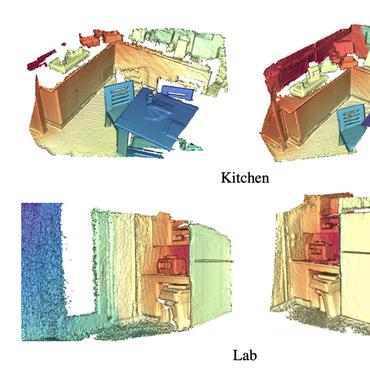Search Results for author: Magnus Oskarsson
Found 17 papers, 7 papers with code
Robust and Accurate Cylinder Triangulation
1 code implementation • 5 Dec 2022 • Anna Gummeson, Magnus Oskarsson
In this paper we present methods for triangulation of infinite cylinders from image line silhouettes.
Extending GCC-PHAT using Shift Equivariant Neural Networks
1 code implementation • 9 Aug 2022 • Axel Berg, Mark O'Connor, Kalle Åström, Magnus Oskarsson
Speaker localization using microphone arrays depends on accurate time delay estimation techniques.
Points to Patches: Enabling the Use of Self-Attention for 3D Shape Recognition
1 code implementation • 8 Apr 2022 • Axel Berg, Magnus Oskarsson, Mark O'Connor
While the Transformer architecture has become ubiquitous in the machine learning field, its adaptation to 3D shape recognition is non-trivial.
 Ranked #6 on
Point Cloud Registration
on 3DMatch Benchmark
Ranked #6 on
Point Cloud Registration
on 3DMatch Benchmark
Orthographic-Perspective Epipolar Geometry
no code implementations • ICCV 2021 • Viktor Larsson, Marc Pollefeys, Magnus Oskarsson
In this paper we consider the epipolar geometry between orthographic and perspective cameras.
Detailed 3D Human Body Reconstruction from Multi-view Images Combining Voxel Super-Resolution and Learned Implicit Representation
no code implementations • 11 Dec 2020 • Zhongguo Li, Magnus Oskarsson, Anders Heyden
Then, taking the low resolution voxel grids which are generated by the coarse 3D models as input, the voxel super-resolution based on an implicit representation is learned through a multi-stage 3D convolutional neural network.
A novel joint points and silhouette-based method to estimate 3D human pose and shape
no code implementations • 11 Dec 2020 • Zhongguo Li, Anders Heyden, Magnus Oskarsson
A novel energy function based on the correspondence is built and minimized to fit parametric model to the silhouettes.
FLIP: A Difference Evaluator for Alternating Images
1 code implementation • Proceedings of the ACM on Computer Graphics and Interactive Techniques 2020 • Pontus Andersson, Jim Nilsson, Tomas Akenine-Möller, Magnus Oskarsson, Kalle Åström, Mark D. Fairchild
Image quality measures are becoming increasingly important in the field of computer graphics.
Deep Ordinal Regression with Label Diversity
1 code implementation • 29 Jun 2020 • Axel Berg, Magnus Oskarsson, Mark O'Connor
By discretizing the target into a set of non-overlapping classes, it has been shown that training a classifier can improve neural network accuracy compared to using a standard regression approach.
 Ranked #2 on
Head Pose Estimation
on BIWI
(MAE (trained with BIWI data) metric)
Ranked #2 on
Head Pose Estimation
on BIWI
(MAE (trained with BIWI data) metric)
Sensor Networks TDOA Self-Calibration: 2D Complexity Analysis and Solutions
no code implementations • 20 May 2020 • Luca Ferranti, Kalle Åström, Magnus Oskarsson, Jani Boutellier, Juho Kannala
Given a network of receivers and transmitters, the process of determining their positions from measured pseudoranges is known as network self-calibration.
Beyond Grobner Bases: Basis Selection for Minimal Solvers
no code implementations • CVPR 2018 • Viktor Larsson, Magnus Oskarsson, Kalle Astrom, Alge Wallis, Zuzana Kukelova, Tomas Pajdla
In this paper we show how we can make polynomial solvers based on the action matrix method faster, by careful selection of the monomial bases.
A fast minimal solver for absolute camera pose with unknown focal length and radial distortion from four planar points
1 code implementation • 27 May 2018 • Magnus Oskarsson
In this paper we present a fast minimal solver for absolute camera pose estimation from four known points that lie in a plane.
Beyond Gröbner Bases: Basis Selection for Minimal Solvers
no code implementations • 12 Mar 2018 • Viktor Larsson, Magnus Oskarsson, Kalle Åström, Alge Wallis, Zuzana Kukelova, Tomas Pajdla
In this paper we show how we can make polynomial solvers based on the action matrix method faster, by careful selection of the monomial bases.
Polynomial Solvers for Saturated Ideals
no code implementations • ICCV 2017 • Viktor Larsson, Kalle Astrom, Magnus Oskarsson
In this paper we present a new method for creating polynomial solvers for problems where a (possibly infinite) subset of the solutions are undesirable or uninteresting.
Efficient Solvers for Minimal Problems by Syzygy-Based Reduction
no code implementations • CVPR 2017 • Viktor Larsson, Kalle Astrom, Magnus Oskarsson
In this paper we study the problem of automatically generating polynomial solvers for minimal problems.
Trust No One: Low Rank Matrix Factorization Using Hierarchical RANSAC
1 code implementation • CVPR 2016 • Magnus Oskarsson, Kenneth Batstone, Kalle Astrom
In this paper we present a system for performing low rank matrix factorization.
On the Minimal Problems of Low-Rank Matrix Factorization
no code implementations • CVPR 2015 • Fangyuan Jiang, Magnus Oskarsson, Kalle Astrom
Low-rank matrix factorization is an essential problem in many areas including computer vision, with applications in e. g. affine structure-from-motion, photometric stereo, and non-rigid structure from motion.
Accurate Localization and Pose Estimation for Large 3D Models
no code implementations • CVPR 2014 • Linus Svarm, Olof Enqvist, Magnus Oskarsson, Fredrik Kahl
For one, it makes the correspondence problem very difficult and it is likely that there will be a significant rate of outliers to handle.







